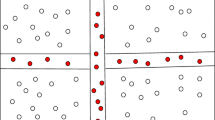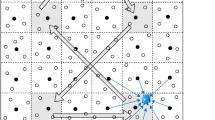Abstract
Recently, Multi-sink Wireless Sensor Networks (WSNs) have received more and more attention due to their significant advantages over the single sink WSNs such as improving network throughput, balancing energy consumption, and prolonging network lifetime. Object tracking is regarded as one of the key applications of WSNs due to its wide real-life applications such as wildlife animal monitoring and military area intrusion detection. However, many object tracking researches usually focus on how to track the location of objects accurately, while few researches focus on data reporting. In this work, we propose an efficient data reporting method for object tracking in multi-sink WSNs. Due to the limited energy resource of sensor nodes, it seems especially important to design an energy efficient data reporting algorithm for object tracking in WSNs. Moreover, the reliable data transmission is an essential aspect that should be considered when designing a WSN for object tracking application, where the loss of data packets will affect the accuracy of the tracking and location estimation of a mobile object. In addition, congestion in WSNs has negative impact on the performance, namely, decreased throughput, increased per-packet energy consumption and delay, thus congestion control is an important issue in WSNs. Consequentially, this paper aims to achieve both minimum energy consumption in reporting operation and balanced energy consumption among sensor nodes for WSN lifetime extension. Furthermore, data reliability is considered in our model where the sensed data can reach the sink node in a more reliable way. Finally, this paper presents a solution that sufficiently exerts the underloaded nodes to alleviate congestion and improve the overall throughput in WSNs. This work first formulates the problem as 0/1 Integer Linear Programming problem, and proposes a Reliable Energy Balance Traffic Aware greedy Algorithm in multi-sink WSNs (REBTAM) to solve the optimization problem. Through simulation, the performance of the proposed approach is evaluated and analyzed compared with the previous work which is related to our topic such as DTAR, NBPR, and MSDDGR protocols.














Similar content being viewed by others
References
Ilyas, M., & Mahgoub, I. (2005). Handbook of sensor networks (pp. 117–140). London: CRC Press.
Xu, C., Cao, L., Zhang, G. A., & Gu, J. Y. (2010). Overview of multiple sink routing protocols in wireless sensor networks. Application Research of Computers, 27(3), 816–823.
Chenge, S. T., & Change, T. Y. (2012). An adaptive learning scheme for load balancing with zone partition in multi-sink wireless sensor network. International Journal of Expert Systems with Applications, 39, 9427–9434.
Xu, C., Cao, L., Zhang, G. A., & Gu, J. Y. (Eds.) (2010). Application Research of Computers, 3, 816.
Awang, A. (2011). Multi-sink routing using path loss in multihop wireless sensor networks. In Proc. Asia-Pacific Conf. on Commun. (APCC2011). Kota Kinabalu, Malaysia, 2–5 October, 2011.
Ammari, H. M. (2009). Challenges and opportunities of connected K covered wireless sensor networks-from sensor deployment to data gathering s. Berlin: Springer.
Pottie, G. J., & Kaiser, W. J. (2000). Wireless integrated network sensors. Communications of ACM, 43(5), 51–58.
Ren, F., Zhang, J., He, T., Lin, C., & Das, S. K. (2011). EBRP: Energy-balanced routing protocol for data gathering in wireless sensor networks. IEEE Transactions on Parallel and Distributed Systems, 22(12).
Liu, X. (2014). A transmission scheme for wireless sensor networks using ant colony optimization with unconventional characteristics. IEEE Communications Letters, 18(7), 1214–1217.
Kanavalli, A., Jayashree, M., Shenoy, P., Venugopal, K., & Patnaik, L. (2008). Hop by hop congestion control system for adhoc networks. In IEEE Proceedings of TENCON (pp. 1–4).
Wan, C. Y., Campbell, A. T., & Eisenman, S. B. (2003). CODA: Congestion detection and avoidance in sensor networks. In Proceedings of the 1st ACM Conference on Embedded Networked Sensor Systems: (SenSys ‘03) (pp. 266–279). Los Angeles, Calif.
Campobello, G., Leonardi, A., & Palazzo, S. (2012). Improving energy saving and reliability in wireless sensor networks using a simple CRT-based packet-forwarding solution. IEEE/ACM Transactions on Networking, 20(1), 191–205.
Zonouz, A., Xing, L., Vokkarane, V., & Sun, Y. (2014). Reliability-oriented single-path routing protocols in wireless sensor networks. IEEE Sensors Journal, 14(11), 4059–4068.
Niu, J., Cheng, L., Gu, Y., Shu, L., & Das, S. (2014). R3E: Reliable reactive routing enhancement for wireless sensor networks. IEEE Transactions on Industrial Informatics, 10(1), 784–794.
Kamal, A. M., Bleakley, C. J., & Dobson, S. (2014). Failure detection in wireless sensor networks: A sequence-based dynamic approach. ACM Transaction on Sensor Networks (TOSN), 10.
Viani, F., Robol, F., Giarola, E., Benedetti, G., De Vigili, S., & Massa, A. (2014). Advances in wildlife road-crossing early-alert system: New architecture and experimental validation. In 2014 European Conference on Antennas and Propagation (EUCAP). The Hague, The Netherlands, 6–11 April 2014.
Viani, F., Rocca, P., Lizzi, L., Rocca, M., Benedetti, G., & Massa, A. (2011). WSN-based early alert system for preventing wildlife-vehicle collisions in Alps regions. In International Conference on Electromagnetics and Advanced Applications (ICEAA 2011) (pp. 106–109). Torino, Italy, September 12–16, 2011.
Eswari, T., & Vanitha, V. (2013). A novel rule based intrusion detection framework for wireless sensor networks. In Proc. of IEEE Int. Conf. Information communication and embedded systems (ICICES). (pp. 1019–1022).
Chen, Y.-L., Lin, Y.-C., & Sun, T.-C. (2013). A prediction scheme for object tracking in grid wireless sensor networks. In Proc. of IEEE 7th Int. Conf. innovative mobile and internet services in ubiquitous computing (IMIS) (pp. 360–364).
Mahboubi, H., Momeni, A., Aghdam, A. G., Sayrafian-Pour, K., & Marbukh, V. (2012). An efficient target monitoring scheme with controlled node mobility for sensor networks. IEEE Transactions on Control Systems Technology, 20(6), 1522–1532.
Chen, C.-C., & Liao, C.-H. (2011). Model-based object tracking in wireless sensor networks. Wireless Networks (WINET), 17(2), 549–565.
Liu, L., Zhang, X., & Ma, H. (2010). Optimal node selection for target localization in wireless camera sensor networks. IEEE Transactions on Vehicular Technology, 59(7), 3562–3576.
Liu, T., Liu, Y., Cui, X., Xu, G., & Qian, D. (2012). MOLTS: Mobile object localization and tracking system based on wireless sensor networks. In Proc. IEEE 7th Int. Conf. on Networking, Architecture and Storage (NAS) (pp. 245–251).
Tan, D. D., & Kim, D.-S. (2014). Dynamic traffic-aware routing algorithm for multi-sink wireless sensor networks. Wireless Networks (IF: 1.055, ISSN: 1572-8196) 20(6), 1239–1250.
Liu, Z., Xu, J., Wang, W., Zhang, Y., & Li, X. (2013). Probabilistic routing algorithm based on naive bayesian classification model in multi-sink sensor networks. Journal of Computational Information Systems, 9, 9943–9951.
Qian, D., Chen, H., Wu, W., & Cheng, L. (2008). Swarm intelligence based energy balance routing for wireless sensor networks. In Proc. of the 2nd Int. Symposium on Intelligent Information Technology Application (vol. 2, pp. 811–815).
Cao, L., Xu, C., & Shao, W. (2010). Multiple sink dynamic estimation geographic routing in wireless sensor networks. In Rocs. of the International Conference on Cyber-Enabled Distributed Computing and Knowledge Discovery (CyberC). Huangshan.
Chen, S., & Yan, N. (2006). Congestion avoidance based on lightweight buffer management in sensor networks. In Proceedings of ICPADS (pp. 934–946).
Sohal, S. H., & Kaur, M. (2014). Improved novel routing algorithm for congestion control in wireless sensor network. International Journal of Computer Applications, 99(18), 21–28.
Kootkar, S. B. (2008). Reliable sensor networks. M.S. thesis, Dept. Comp. Eng., TU Delft Univ., Delft, Netherlands.
Elfouly, F. H., Ramadan, R. A., Mahmoud, M. I., & Dessouky, M. I. (2016). Resource aware and reliable data reporting algorithm for object tracking in WSNs. International Journal of Intelligent and Fuzzy systems, 31, 99–113.
Elfouly, F. H., Ramadan, R. A., Mahmoud, M. I., & Dessouky, M. I. (2013). SWARM intelligence for balancing energy and reliable routing in homogenous WSNS. International Journal of Applied Mechanics and Materials, 9(4), 622–630.
Liu, A., Ren, J., Li, X., Chen, Z., & Shen, X. S. (2012). Design principles and improvement of cost function based energy aware routing algorithms for wireless sensor networks. Computer Networks, 56(7), 1951–1967.
Zhang, D., Li, G., Zheng, K., Ming, X., & Pan, Z.-H. (2014). An energy-balanced routing method based on forward-aware factor for wireless sensor networks. IEEE Transactions on Industrial Informatics, 10(1), 766–773.
Bhattacharjee, S., & Bandyopadhyay, S. (2013). Lifetime maximizing dynamic energy efficient routing protocol for multi hop wireless networks. Simulation Modelling Practice and Theory, 32, 15–29.
Fdili, O., Fakhri, Y., & Aboutajdine, D. (2012). Impact of queue buffer size awareness on single and multi service real-time routing protocols for WSNs. International Journal of Communication Networks and Information Security, 4, 104–111.
Yaessad, S., Bouallouche-Medjkoune, L., & Aïssani, D. (2015). A cross-layer routing protocol for balancing energy consumption in wireless sensor networks. Wireless Personal Communication, 81(3), 1303–1320.
Verma, V. K., Singh, S., & Pathak, N. P. (2014). Analysis of scalability for AODV routing protocol in wireless sensor networks. Optik—International Journal for Light and Electron Optics, 125(2), 748–750.
Jian, D. (2012). Cloud model and ant colony optimization based QoS routing algorithm for wireless sensor networks. In Y. Wu (Ed.), International Conference on WTCS 2009, AISC 116 (pp. 179–187). Heidelberg: Springer.
TD5250 datasheet available online at http://www.alldatasheet.com/view.jsp?Searchword=Tda5250.
Author information
Authors and Affiliations
Corresponding author
Rights and permissions
About this article
Cite this article
El-Fouly, F.H., Ramadan, R.A., Mahmoud, M.I. et al. REBTAM: reliable energy balance traffic aware data reporting algorithm for object tracking in multi-sink wireless sensor networks. Wireless Netw 24, 735–753 (2018). https://doi.org/10.1007/s11276-016-1365-1
Published:
Issue Date:
DOI: https://doi.org/10.1007/s11276-016-1365-1




